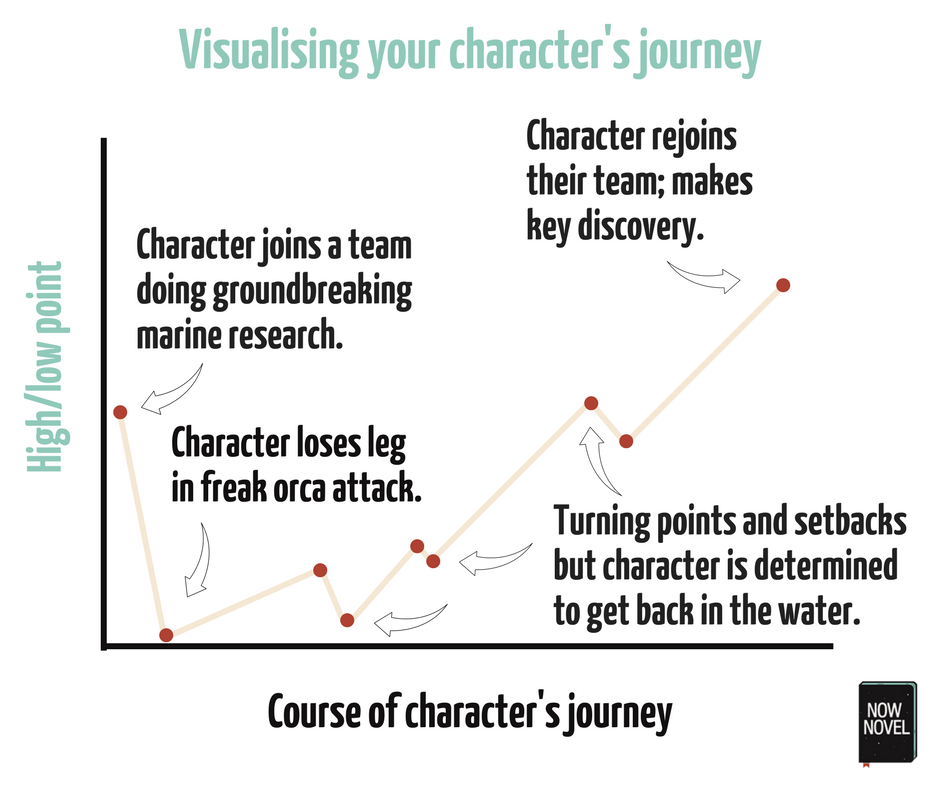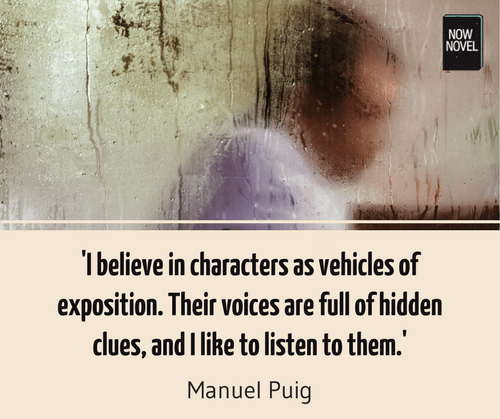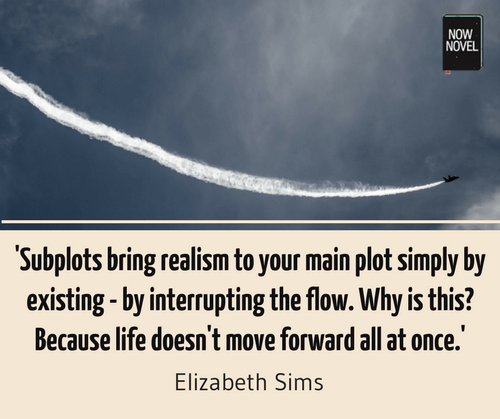When you’re writing a first or even second draft, the parts of a story – exposition, development, and ending – often feel disconnected. For a cohesive plot, think in long-form development (character and story arcs) rather than in individual, isolated plot events. Read tips to make the separate parts of your story mesh together better:
1. Link action and reaction in primary characters’ arcs
Longer arcs of action and reaction in your story help to create connection between individual scenes, chapters and sections. When actions and reactions in stories fan out from pivotal events and experiences your character has, we get a character arc. How will your character act in situation A? How will they react to consequence B?
Let’s take an example: Imagine a character who is a marine biologist who works with orca whales. A freak orca attack results in the character losing a limb in Chapter 1.
The action of this first chapter may ripple to the next chapter (the immediate, emotional fallout, for example: The character coming to terms with this loss). Yet it can also ripple throughout the story, showing the reactions and chain reactions that result.
For example, if the character reacts in fear, they may struggle to resume working in the field. How does having to find a new source of survival add to their struggle?
On the other hand, maybe the character finds great courage and returns to work once recovered. You could show the motivating effects of their personal courage and determination on their colleagues. Perhaps together the team shows bravery none thought they were capable of before.
This rippling out of action and reaction is essential for a cohesive (i.e. inter-connected) story. One way you can find the connected pathways between action and reaction for individual characters is by creating a visual timeline. Plot your protagonist’s (i.e. main character’s) high and low points as your story unfolds.
A condensed example:

Keeping the broader picture in mind will help you create throughput from early events and scenes to everything that follows.
2. Plant the seeds of important story arcs in your exposition
The exposition of a story is the introductory section that ‘gives the audience or reader the background of the characters and the present situation’ (dictionary.com). Before you write your exposition, it’s key to have a clear idea of your story’s overarching idea [find one using Now Novel’s simple tools if you don’t have a clear idea yet].
For example, in the exposition of our example story, we’d likely learn early that the main character is a marine biologist. We might also learn she’s tough and headstrong and unafraid to take personal risks for her profession.
For the above story idea, you could write an expository (introductory) scene or chapter showing your main character arguing with a colleague or superior about a risky dive. Showing your character’s determination at the start of your story here would also explain how they find the determination to persist in their recovery and resume their work.
When you write the exposition of your novel or short story, think about:
- Character development: Do you have an idea of how your character’s personality will affect important events in your story? Show these traits in your exposition. For example, in the Greek myth of Pandora, Pandora’s curiosity leads her to open a box that unleashes evil in the world. Here, exposition laying foundations for Pandora’s arc could show a milder incident where young Pandora’s inquisitive mind gets her into trouble
- Tension and conflict: Given your central idea, what might the primary conflicts or character challenges be in your story? For example, in a story involving grievous personal injury, character-versus-self (a character struggling to come to terms with their circumstances) could feature. If this is the primary conflict, you could underscore your protagonist’s love of freedom in your early chapters, to create a greater contrast between their starting point and the twists of fate along their journey
- Goals and motivations: What does your character want most? What do they fear most? If the marine biologist has great ambition, you could show this as a motivation for why she puts herself in danger for her career
3. Develop your story and themes from your exposition
After the introductory exposition of your first chapters, the development is the next crucial part of your story.
The development is one of the parts of a story where writers most often get stuck. Sometimes this is because we don’t have a bird’s eye view of what will happen – a sense of where everything is headed. The visual exercise above helps (as does outlining your story in full). Essentially, when it comes to cohesive character and plot development, Ray Bradbury was right:
‘[Plot] is human desire let run, running, and reaching its goal.’
Focus on expanding the character desires and goals (as well as story themes and situations) you introduced in your exposition.
For example:
- Themes linked to character goals and motivations: A character you introduce as fearless in their ambition may also be foolhardy. What are the dangers of having lots of ambition? What are the positives? The imaginary story arc outlined above suggests some answers. For example, the idea that total commitment sometimes has costs, even including personal danger or loss
- Obstacles and solutions created out of your starting scenario: If a secondary character was dead against the main character’s decision that led to serious accident, how might they react upon their return to the workplace? Perhaps they create politics and try to limit the main character’s power. Because they’re fearful of a repeat. This could become a further obstacle for the main character to overcome as they persist and pursue their primary goal

4. Use subplots related to primary arcs and themes to create further cohesion
One way to weave the separate threads of your story together is to incorporate related, connected subplots.
For example, a secondary character in our example story might struggle with a loss of their own, in parallel with the main character. Perhaps they’ve lost a romantic partner (to death or divorce) or are grappling with another momentous change.
You could use this character’s arc to illustrate, for example, how remarkable your main character’s perseverance is given the emotional difficulty of adjusting to loss. Perhaps those around them facing setbacks of their own aren’t as strong, for example, and take self-destructive paths. Your main character’s example could even cause them to reevaluate their own choices. This is a type of subplot typical of motivational and inspiring stories of survival.
However you use them, subplots are a great tool for adding depth and variety to your story, bringing in extra tensions, intrigues and developments.

5. Lead the parts of a story to a fitting end
If you’ve paid attention to how the parts of a story fit together, you’ll likely have a sense already of how you want your book to end. There are many different ways to end a story, yet a fitting end simply makes sense given the buildup.
For example, many viewers were frustrated when David Lynch brought his hit murder mystery TV series Twin Peaks to a cliffhanger end. Yet others understood this choice: The series explained suburban dysfunction through paranormal and supernatural events. The director showed a dark, often inexplicable spirit world coexisting alongside his small town. Thus it made sense that not every mystery was tied up in a neat bow. That way, the story’s monsters weren’t all resolved (like in a Scooby Do cartoon where ghosts turn out to be realtors in fancy dress).
How do you decide on a fitting end that adds to your story’s cohesion?
- Bring characters’ arcs to logical conclusions: If your character will stop at nothing to reach their goal, show the final results
- Resolve primary conflicts: Do characters in conflict have a grand final battle where there can only be one victor? Do they set their conflict aside, uniting against an even greater, mutual foe? How could your story’s primary conflicts and character obstacles come to a climax?
- Use foreshadowing to suggest possible outcomes: If a character dies facing a terrifying villain in the end (a tragic ending), think about how you can show the extent of your villain’s power earlier at high points of tension in your story
Need help seeing how the parts of a story could fit together? Work one-on-one with a writing coach or share a summary of your story for feedback from Now Novel’s writing community.


3 replies on “The parts of a story: Creating a cohesive whole”
This is great stuff, I especially love the part about sub plots. I like to try to have several detailed subplots in my action adventure novels
They are useful indeed for making an initial idea more expansive and complex. Thanks for reading and sharing your thoughts.
[…] Use a consistent theme or style to create a cohesive narrative […]